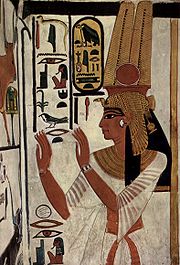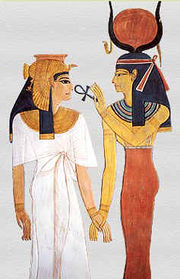Nefertari
- For other persons by this name see Nefertari (disambiguation).
| Queen Nefertari | |
|---|---|
 Tomb wall depicting Queen Nefertari, the great royal wife of pharaoh Rameses II. |
|
| Born | circa 1290 BC Unknown |
| Died | circa 1256 BC Unknown |
| Occupation | Unknown |
| Spouse | Rameses II |
Nefertari (Nefertari Merytmut or Mut-Nefertari) (c. 1290 –– 1254 B.C.E.) was one of the Great Royal Wives (or principal wives) of Ramesses the Great. Nefertari means Beautiful Companion. She is one of the best known Egyptian queens, next to Cleopatra, Nefertiti and Hatshepsut. Her lavishly decorated tomb, QV66, is the largest and most spectacular in the Valley of the Queens. Ramesses also constructed a temple for her at Abu Simbel next to his colossal monument here.
Contents |
Biography

Although Nefertari’s origins are unknown, discoveries from her tomb, including a cartouche of Pharaoh Ay, suggest she may have been related to the 18th Dynasty, which included Tutankhamun, Queen Nefertiti, the so-called "heretic king" Akhenaten and the dynasty's penultimate pharaoh, Ay. Around age thirteen Nefertari married Ramesses II, only fifteen, before he ascended the throne. She became one of his two Great Royal Wives, the other was Isetnofret, but Nefertari is better known from statues and monuments. She remained the most important of his wives for at least the next twenty years. By the 1240s BC her prominence appears to wane, and her images by the Pharaoh's side become scarce.
Nefertari had at least four sons and two daughters, although none of these children succeeded the throne. Ramesses’ heir was Prince Merneptah, his 13th son by Isetnofret. Ramesses sired at least forty-eight to fifty sons during his long reign. Nefertari died during the Regnal Year 25 of Ramesses' reign. Her daughter Meritamen was elevated to the rank of Great Royal Wife around this time.
Status
Nefertari was quite probably the only Egyptian royal wife, other than Queen Tiy, to be deified during her lifetime. Ramesses' temple at Abu Simbel also has a smaller temple nearby dedicated to Nefertari and the goddess Hathor—a very unusual act, as temples were usually dedicated to deities, not mortals.
Her status is confirmed by the fact that she was depicted as part of her husband’s entourage, even during important voyages such as a trip to Nubia to commission a new temple built at Abu Simbel. Nefertari is also depicted as being equal in size to Ramesses, a rarity indicating her importance to the pharaoh.
Her prominence is further supported by cuneiform tablets from the Hittite city of Hattusas (today Boghazkoy, Turkey), containing Nefertari's correspondence with the king Hattusilis and his wife Pudukhepa. she is mentioned in the letters as Naptera. She appears to have been instrumental in maintaining peace between Egyptians and Hittites, which eventually led to Ramesses’ marriage to a Hittite princess.
Ramesses’ unusual affection for his wife, as written on her tomb's walls, shows that some ancient Egyptian marriages were not simply matters of convenience or means to accumulate greater power and alliances, but were based around emotional attachment. Poetry written by Ramesses about his dead wife is featured on some of the walls of her burial chamber. ("My love is unique—no one can rival her, for she is the most beautiful woman alive. Just by passing, she has stolen away my heart.")
Titles
Ramesses referred to his beloved wife as "the one for whom the sun shines." She was also often referred to as Nefertari Merit-en-Mut, meaning "the Beautiful Companion, Beloved of Mut."
Nefertari's Children
Ramesses II fathered at least 100 children during his lifetime. Not all of their names are known, and in many cases their mothers are difficult to establish with any kind of certainty. These children of Ramesses have been attributed to Nefertari by various authors; however, the list is by no means exhaustive.
- Prince Amun-her-khepeshef, Crown Prince, Commander of the Troops
- Prince Pareherwenemef
- Prince Meryatum, High Priest of Heliopolis
- Prince Meryre
- Princess Meritamen, Singer of Amun and Priestess of Hathor
- Princess Henuttawy
- Princess Beketmut (?)
- Princess Nefertari (?)
- Princess Nebettawy (?)
The first six are shown on the small Abu Simbel temple and based on this, they can be identified as Nefertari's children.
In popular culture
- Nefertari was portrayed in The Ten Commandments as Queen Nefertiri, and was played by Anne Baxter. In the film, Nefertiri is deeply, head-over-heels in love with Moses, and hates Ramesses (or Rameses, as he is called in the film). She turns against Moses after he returns from exile and tells her, "The Moses who loved you was another man", and begins to hate him after her firstborn child dies as a result of one of the Ten Plagues of Egypt; the death of Nefertiri's son occurs partly as a result of Rameses's desire to kill Moses's son, whom Nefertiri tries to save. (When Pharaoh expresses his desire to kill Moses's son, according to Moses, the desire "boomerangs" on him and causes a "reverse effect", ensuring the death of Rameses's son.)
- She features prominently in the Ramses series of novels by Christian Jacq.
- She features in the 2001 film The Mummy Returns as the daughter of Seti I. (this is an inaccurate interpretation)
- In the novel The Heretic Queen by Michelle Moran, Nefertari is the principal character, with the real life Mutnodjmet portrayed as her mother.
External links
References
- Nos ancêtres de l'Antiquité, 1991, Christian Settipani, p. 176
- Grajetzki, Wolfram (2005) Ancient Egyptian Queens – a hieroglyphic dictionary
- Reeves, N et al., (1996) The Complete Valley of the Kings
- Rosalie David, (1998) Handbook to Life in Ancient Egypt
- Shaw, Ian (2000), The Oxford History of Ancient Egypt
- Shaw, Ian (1995), The British Museum Dictionary of Ancient Egypt
- Siliotti, A. (2002), Egypt: Splendours of an Ancient Civilisation. Italy: Thames & Hudson.
- Bradley, P. (1999), Ancient Egypt: Reconstructing the Past. United Kingdom: Cambridge.
- Hagen,R&R. (2003), Egypt: People, Gods, Pharaohs. Maat & cartouche of Nefertari, pg 41.
- Leblanc, C. (2001). Osiris.net [internet]. [place of publication unknown]. [publisher unknown]. Available from: <http://www.osirisnet.net/tombes/pharaons/nefertari/e_nefertari.htm>[27/02/2005].
- "Women in power B.C. 4500-1000 from Guide2womenleaders.com, URL accessed 03/21/06
|
|||||||||||||||||||||||||||||||